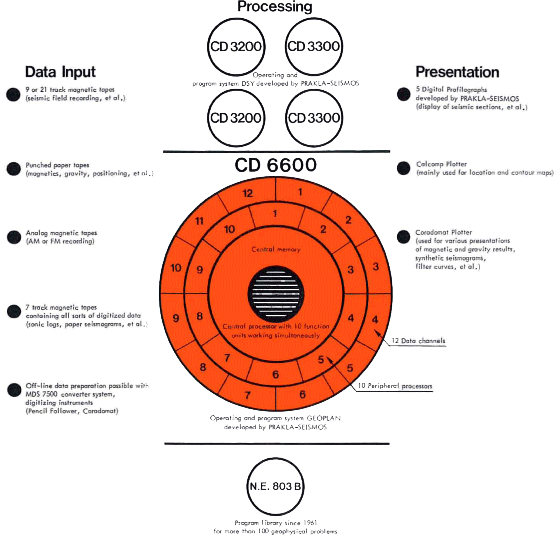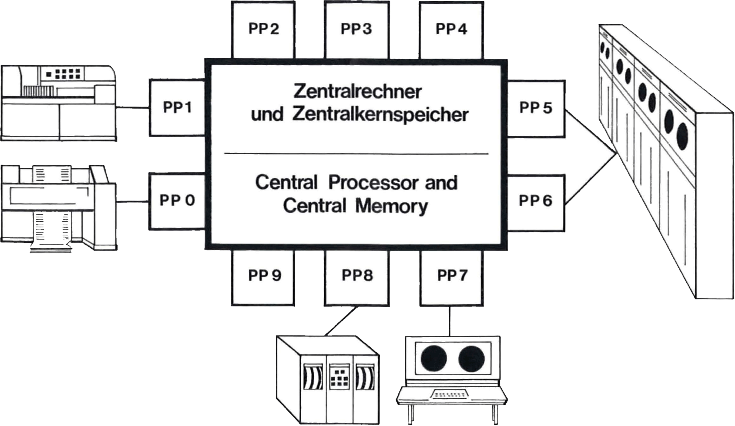
Die Rechenanlagen aus der Serie 6000 der Control Data Corporation gehören seit mehreren Jahren zu den leistungsfähigsten der Welt. Es ist das organisatorische Konzept, das diesen Systemen eine überlegene Kombination von Geschwindigkeit, Vielseitigkeit und leichter Benutzbarkeit verleiht. Die zentrale Verarbeitung der Daten ist vollständig von deren Ein-und Ausgabe getrennt, beide Arten von Arbeiten werden gleichzeitig ausgeführt. Die Abbildung auf dieser Seite zeigt das Aufbauprinzip des Systems CD 6600. Die Skizze läßt erkennen, daß die 12 Datenkanäle und 10 peripheren Rechner durch den Zentralspeicher vollständig von dem Zentralrechner getrennt sind.
Zunächst einige technische Daten:
Large Computer System CD 6600
The computer plants from Control Data Corporation's Series 6000 have belonged to the world's most efficient on es for several years. It is the organizing design concept which gives these systems an outstanding combination of speed, flexibility, and simplicity in use. The central processing of data is completely separated from the data input and output, both being carried out simultaneously. The figure on this page gives the structural principle of the CD 6600 system. The sketch shows that the 12 data channels and 10 peripheral processors are completely separated from the central processor by the central memory.
A few technical data:
Die Rechenwerke sind wie folgt aufgeteilt:
32 K-Worte zu je 60 Bit Magnetkernspeicher, aufgebaut in Bänken zu je 4 K-Worten (K = 1024).
32 K-words (each word 60 bits), built up in 8 blocks of 4 K-words (K = 1024).
Enthalten je 4 K-Worte Kernspeicher zu je 12 Bit für Programme und Daten.
Each contains 4 K-words core memory (each word 12 bits) for programs and data.
In beiden Richtungen können je Kanal 1 Mio 12 Bit-Worte in der Sekunde übertragen werden.
Each channel can' transmit up to 1 million 12 bit words per second in both directions.
Trotz der enormen Rechenleistung kann das Programmieren in gewohnter Weise erfolgen (FORTRAN, ALGOL, COBOL u. a.). Das Betriebssystem SCOPE der 6000-Serie führt überwachungsund Betriebsaufgaben automatisch durch.
Letztlich hängt es aber vom Aufbau der Programme ab, ob die Möglichkeiten des Systems CD 6600 genutzt werden, d. h. ob die 10 Rechenwerke und die 10 peripheren Rechner gleichzeitig und sinnvoll eingesetzt werden. Um eine Optimierung der Programme zu erreichen, muß man bei den einzelnen Aufgaben, die gelöst werden sollen, genau überlegen, in welcher Art und Weise man die einzelnen Operationen zeitlich ablaufen läßt. In der Praxis werden vorgegebene Termine oft verhindern, daß ein Programm optimiert wird. Da aber wirtschaftliche Uberlegungen beim Betrieb des PRAKLA-SEISMOS-Datenzentrums eine ausschlaggebende Rolle spielen müssen, wurde von uns die Programmsprache GEOPLAN entwickelt, die die Probleme der Geophysik in ähnlicher Weise zu lösen gestattet, wie z. B. die Sprache FORTRAN das in der Mathematik tut. GEOPLAN ist die Abkürzung für Geophysical Language. Man nimmt bei dieser geophysikalischen Sprache als Einheiten die Prozesse, die immer wieder in der Datenverarbeitung der Geophysik auftauchen, z. B. Kreuzkorrelationen, Korrigieren, Falten, Normieren, Spurzusammenfügen.
Aus diesen elementaren optimierten Programmteilen, die wir Moduln nennen, lassen sich mit relativ wenig Programmieraufwand beliebige Prozeßfolgen aufbauen, die eine vorteilhafte Ausnutzung der Rechenkapazität des Systems CD 6600 garantieren.
Die Abbildung auf der nächsten Seite zeigt den schematischen Aufbau des im PRAKLA-SEISMOS-Datenzentrum installierten Systems CD 6600 einschließlich der durch das Betriebssystem GEOPLAN vereinbarten Arbeitsteilung der 10 peripheren Rechner.
Despite the vast computation performance, programming can follow the usual pattern (FORTRAN, ALGOL, COBOL, etc.). The SCOPE operation system of the 6000 series carries out operational and control tasks automatically. However, it depends ultimately on the structure of the programs, whether or not the capacity of the CD 6600 system is fully used, i. e. whether the 10 arithmetic units and the 10 peripheral processors are employed simultaneously and meaningfully. To achieve an optimation of the programs one must consider closely, for each problem to be solved, by which ways and means one should let the individual processes run off successively. In practice pre-set terms often hinder the optimizing of a program. As however economic considerations must play a decisive role in the PRAKLA-SEISMOS Data Center, we have developed the GEOPLAN programming language. This language serves to solve geophysical problems in a way similar to the solving of mathematical problems by the FORTRAN language. GEOPLAN is the abbreviation for Geophysical Language. The units in this language are the processes which always reoccur in data processing in geophysics, for example cross correlations, corrections, folding, normalizing, compositing of traces, etc. On these fundamental and optimated program components, which we call modules, optional process sequences can be built up with relatively little programming work, process sequences which guarantee profitable exploitation of the computing capacity of the CD 6600 system. The figure on the next page shows the schematic structure of the CD 6600 system installed in the PRAKLA-SEISMOS Data Center, together with the operating subdivision of the 10 peripheral processors organized by the GEOPLAN operation system.
PP 0 Steuerung des Zeilendruckers
PP 1 Steuerung des Lochkartenlesers
PP 2 Verwaltung des Betriebs-und Programmsystems GEOPLAN.
PP 3 Verwaltung der Parameter
PP 4 Bereitstellung der statischen Korrekturen.
PP 5 Steuerung der Ein-bzw. Ausgabe für die Magnetband
PP 6 laufwerke.
PP 7 Steuerung der 2 Bildschirme, auf denen bestimmte Zustände
PP 8 Steuerung des Transfers von Daten zu dem Plattenspeicher
PP 9 soll später den DatenfluB zu einem direkt angeschlossenen
Die optimale Ausnutzung des Systems CD 6600 in der derzeitigen Konfiguration setzt voraus, daß z. B. die zu verarbeitenden seismischen Daten entsprechend vorsortiert sind. Diese Vorarbeiten werden mit dem Programmsystem DSY an den 3000-Systemen durchgeführt. Im Normalfall bedeutet dies: Einlesen der Daten eines Seismogrammes vom Feldband, Demultiplexen und Sortierung nach Untergrundpunkten, Ausgabe auf 7-Spur-Magnetband im 30-bit-Wort-Format (Gleitkomma).
PP 0 Control of the line printer
PP 1 Control of the punched card reader
PP 2 Management of the GEOPLAN operation and prograrn
PP 3 Management of parameters
PP 4 Provision of static corrections
PP 5 Control of input and output for the magnetic tape units
PP 5
PP 7 Control of the two screens on which particular states of the
PP 8 Control of the transfer of data to the disc unit CD 6603
PP 9 Will later control the flow of data to a directly connected
The optimal utilization of the CD 6600 system in its present configuration presupposes for example, that the seismic data to be processed are correspondingly presorted. This preliminary work is carried out with the DSY program system on the 3000 series computers. Normally this means the input of records from the fjeld tapes, demultiplexing and sorting of data according to subsurface points and output on 7 track magnetic tapes in 30 bit word format (floating point).
